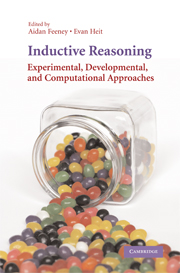Book contents
- Frontmatter
- Contents
- List of Figures
- List of Tables
- List of Contributors
- Preface
- 1 What Is Induction and Why Study It?
- 2 The Development of Inductive Reasoning
- 3 Interpreting Asymmetries of Projection in Children's Inductive Reasoning
- 4 Property Generalization as Causal Reasoning
- 5 Availability in Category-Based Induction
- 6 From Similarity to Chance
- 7 Theory-Based Bayesian Models of Inductive Reasoning
- 8 Use of Single or Multiple Categories in Category-Based Induction
- 9 Abductive Inference: From Philosophical Analysis to Neural Mechanisms
- 10 Mathematical Induction and Induction in Mathematics
- 11 Induction, Deduction, and Argument Strength in Human Reasoning and Argumentation
- 12 Individual Differences, Dual Processes, and Induction
- 13 Taxonomizing Induction
- Index
13 - Taxonomizing Induction
Published online by Cambridge University Press: 26 February 2010
- Frontmatter
- Contents
- List of Figures
- List of Tables
- List of Contributors
- Preface
- 1 What Is Induction and Why Study It?
- 2 The Development of Inductive Reasoning
- 3 Interpreting Asymmetries of Projection in Children's Inductive Reasoning
- 4 Property Generalization as Causal Reasoning
- 5 Availability in Category-Based Induction
- 6 From Similarity to Chance
- 7 Theory-Based Bayesian Models of Inductive Reasoning
- 8 Use of Single or Multiple Categories in Category-Based Induction
- 9 Abductive Inference: From Philosophical Analysis to Neural Mechanisms
- 10 Mathematical Induction and Induction in Mathematics
- 11 Induction, Deduction, and Argument Strength in Human Reasoning and Argumentation
- 12 Individual Differences, Dual Processes, and Induction
- 13 Taxonomizing Induction
- Index
Summary
The chapters in this book offer a variety of perspectives on induction. This is not shocking, as inductive problems are both fundamental and unsolvable. They are fundamental in that organisms must solve them in order to know most of the things about their environment that they cannot observe directly, like what's around the next corner or what to expect from that woolly mammoth over there. They are unsolvable in that uncertainty cannot be eliminated. However we define induction, as discussed in Heit's Chapter 1, it involves conclusions that we cannot be sure about. There seems to be general agreement with Hume's (1748) conclusion that no logic of justification for inductive inference is possible.
Despite the variety of perspectives, the chapters revolve around three central themes concerning, respectively, the prevalence of induction, how to carve up the space of inductive inferences, and the role of causality. I will briefly discuss each in turn.
THE PREVALENCE OF INDUCTION
The consensus in these essays is that most of the conclusions that people come to have an inductive basis and that little human reasoning is well-described as deductive. Indeed, the brunt of Oaksford and Hahn's Chapter 11 is that probabilistic inference is the dominant mode of human reasoning, a claim echoed by Heit and by Thagard (Chapter 9).
Even the Rips and Asmuth Chapter 10 leaves the reader with the impression that deductive reasoning is exceptional. Rips and Asmuth make a strong argument that inductive proofs in math have the strength of deductive inference, that they are deductive proofs in disguise.
- Type
- Chapter
- Information
- Inductive ReasoningExperimental, Developmental, and Computational Approaches, pp. 328 - 344Publisher: Cambridge University PressPrint publication year: 2007
- 2
- Cited by



